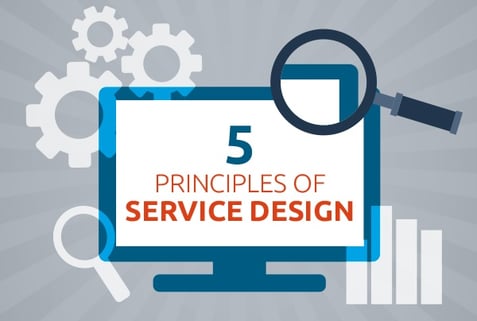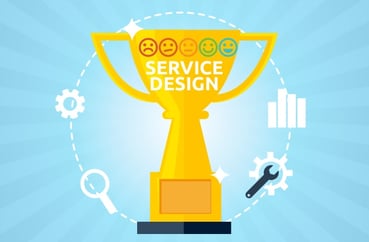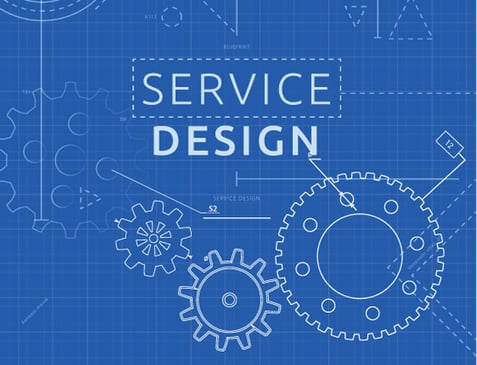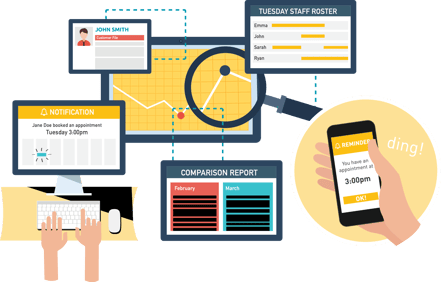Everything you need to know
Contents
Here, we outline exactly what Service Design is, how it works and why you need it, in short, digestible chunks. You can read our guide from top to bottom, or skip to a point that is most relevant for your needs.
 For your service design to be successful, there are five core principles you need to follow:
For your service design to be successful, there are five core principles you need to follow:
Design your services based on how they are experienced
Understanding every user’s expectations, preferences, values, beliefs and core decision making influences will enable you to provide a high standard of service that is truly customer-centric.
All stakeholder groups should be involved in the service design process.
Co-creation refers to the process in which all users are involved not just in the design of the solution, but also in the production and development of it too.
One of the main features of service design is not avoiding making mistakes but learning from them.
This is achieved by prototyping and testing. You can save a large amount of time and money if you test the customer experience before spending lengthy periods of time developing it.
In a collaborative team environment, it is more expressive to use visual aids than to rely purely on words.
Have your team use sketches, pictures, graphs, maps and prototypes where applicable. Visual tools enable the viewer to digest even the most complex of ideas. Through the use of visual aids, you can properly explain what you’re trying to achieve and make the information easier to remember.
The entire environment in which the service exists and is delivered should be considered.
Holistic services look at the whole user journey and consider each person’s touchpoint – this includes staff usage as well as customer usage.
 Service Design is fast becoming a buzz word in the strategy world, but why? Let’s start by defining what it is.
Service Design is fast becoming a buzz word in the strategy world, but why? Let’s start by defining what it is.
Service Design is the activity of planning and organising people, infrastructure, communication and material components of a service to improve not only the quality of the service but also the interaction between the service provider and its customers. It’s about giving value and getting results.
Service Design is strategic, holistic and collaborative and is both a creative and practical way to improve and innovate existing services and design new ones.
Consumers today expect more so services need to be able to reflect that. Find out more about Service Design Solutions here.
 There’s no denying that service design will improve and innovate your existing Healthcare service or help you design new ones, but there may be barriers along the way. We look at how to approach these barriers with suggested solutions to overcome them.
There’s no denying that service design will improve and innovate your existing Healthcare service or help you design new ones, but there may be barriers along the way. We look at how to approach these barriers with suggested solutions to overcome them.
Communication is paramount. Ultimately applying service design to your organisation is extremely rewarding, although you may need to overcome some of these challenges along the way. Read more here.
With the rise of a global pandemic along with aging populations and other conditions, there has never been a greater need for quality medical services. The question is, how do you make the right decisions for your organisation to ensure your choice meets your objectives?
How does improved service design make a difference? Read more here.
 One of the common misconceptions in the healthcare industry is that the patient experience should be focused predominantly on healthcare alone.
One of the common misconceptions in the healthcare industry is that the patient experience should be focused predominantly on healthcare alone.
The general public’s rising expectations of healthcare services means that every provider must take steps to improve their patient interactions.
Generally speaking, considering the patient experience has been an underutilised idea for improving healthcare services for many years. However, growing evidence points towards patients now looking for excellent, streamlined service as a highly important factor around their perception of a positive experience.
The key to improving service design when it comes to patient satisfaction levels revolves a lot around your teams and the systems that support them. More than anything, providing a positive patient experience also empowers your staff to feel fulfilled and satisfied with their work as well.
At NEXA, we believe in human-centred service design. Excellent service design ensures that all aspects of a patient’s healthcare journey make them feel valued and respected. It involves creating a positive environment for patients, staff, carers and volunteers through effective communication and the recognition of needs. Coupled with safe and high-quality care, service design minimises patient dissatisfaction and enables you to deliver a holistically pleasant experience – every time.
 A service design blueprint is essentially the patient’s journey, mapped out from start to finish, with all of the supportive services included, showing the role each play at every stage.
A service design blueprint is essentially the patient’s journey, mapped out from start to finish, with all of the supportive services included, showing the role each play at every stage.
For instance, the first patient step may be their interaction with the clinic when looking to book an appointment. So, at this initial touchpoint, the service blueprint would detail how the patient can book the appointment, such as calling or booking online, as well as what the systems and staff do at this point – and so on.
By spending the time mapping out the entire patient journey, it’s easier for your team to see where the best service is being provided and where improvements need to be made. A service design blueprint shows all of the systems and staff activities that support the patient journey so that these “behind the scenes” events can be identified and improved.
Much like in theatre, all activities observed or undertaken by patients are considered the ‘front stage’, whereas the backstage processes that they are unaware of are considered ‘behind the scenes’. Interactions with staff make up a significant portion of the patient’s front stage experience.
Healthcare tends to be a high-pressure environment. So, mapping out a service blueprint can give your team more control. This includes breaking down the people, processes and resources that make up the patient experience.
Providing excellent customer service in any industry is no easy feat – and healthcare is no different. But there are ways to streamline the process and make the process easier both for the employees working behind the scenes and the patients receiving the services on the front stage. Therefore, if you want to streamline the process for the benefit of both your patients and your team, it’s important to map out a service design blueprint for your healthcare organisation.
Get in touch with NEXA for our Service Design consulting services, or read more about Service Design blueprints here.

Design thinking is an investigative and collaborative process that involves empathising with the users of a product or service to inform and improve upon its shortcomings. When applied to service delivery in a government context, design thinking requires decision-makers to challenge preconceived ideas about their customers, and instead, remain open to working with them towards alternative ways of meeting their needs.
• Looking beyond ingrained patterns of thinking
When faced with a problem, it’s human nature to jump to a solution using habitual thinking patterns. Overcoming this tendency in favour of ‘thinking outside the box’ allows service providers to question the conditions of the apparent problem, and provide an innovative solution.
• Empathising with your customers through consultation
Effective use of design thinking in service delivery starts with understanding the needs and expectations of your customers.
• Involving customers in co-creating solutions
Once the root issue is clear, placing your customers’ experience goals at the core of the redesign process will typically return the best possible results.
• Getting it right through experimentation and iteration
Service redesign is rarely sequential, straightforward, or linear, and robust testing is in the best interest of both the organisation and its customers, long-term.
• The benefits of employing design thinking are clear
Like all service providers, governments cannot afford to make assumptions about their customers’ needs, and while there is no silver bullet approach to perfecting service delivery, employing design thinking can go a long way towards co-creating the most valuable, meaningful service.
It stands to reason that involving customers in service problem identification and solution-based iteration, offers benefits to both governments and the very people they wish to serve. Read more about Design Thinking here.
 We’re living in a world of instant gratification, where the customer demands an enjoyable, valuable and convenient journey when interacting with your business.
We’re living in a world of instant gratification, where the customer demands an enjoyable, valuable and convenient journey when interacting with your business.
Yet despite its critical importance, many service organisations struggle to provide a truly novel, visionary and exceptional customer experience.
Here are 10 things you need to do to improve your CX:
Read more about this here.

Katie Bowden, NEXA’s Service Design Director, has spent 12 years with the Local Health Districts in NSW Health as an information manager. She is passionate about informatics and making processes better for patients, and the people delivering them. In our short interview with Katie, she reveals how strategic Service Design leads to a new way of thinking.
Q. Why is it important in today’s world and will it continue to have a place as consumer behavior shifts online for many services?
Customers have become more tech-savvy and now more than ever have the power to research and choose between endless competitors providing similar services. Service Design can be used as an approach to bridge the gaps between what the organisation can do and what customers need and want. The result will be an experience that builds lasting customer relationships.
NEXA was integrally involved in the digital transformation at Service New South Wales (SNSW) and continues to support their service revolution. As an organisation, they have done an outstanding job of using Service Design principles to not only improve the customer experience but also the experience for their service providers, and in the process, demonstrate how effective and essential Service Design is to remain relevant to their customers.
Q. How do organisations know if they need to address the design of their services?
As an organisation or service provider, if you have ever thought “there has to be a better way!”, then rest assured, your customers have too! There IS a better way…. and it can be achieved by Service Design.
Q. How is Service Design and Customer Experience related?
Service Design and Customer Experience are closely related and work hand-in-hand. Without good Service Design, customer experience suffers.
Q. Can you give us a before and after scenario of where Service Design had a major impact on customer experience?
A recent piece of work we completed at NEXA is Blacktown City Council. The service centre were experiencing increasing frustration from their customers which they were taking out on the council staff who were trying to serve them.
NEXA facilitated Blacktown City Council by putting a self-service kiosk at each entrance which allowed customers to select the services they required and take a ticket to join a virtual queue. The agent knows why the customer is there before they approach the desk and so can provide a more efficient service. Wait times have been reduced to under 3 minutes, service times are around 7 minutes and management can plan staff schedules and training according to the changing needs of their customers.
Read the full interview with Katie here.
![]()
![]()
![]()
![]()
![]()
Holistic Services
Holistic Services are services that look at the whole patient journey and consider each touch point of that journey. Service blue prints, user journeys and scenarios investigate holistic patient experiences and touch points.
Following the basic principles of service design, the practical and applied framework is the service design process. The objective of this 4 step process is to effectively and holistically manage the quality and consistency of service delivery including customer interactions and experiences across the organization.
Essentially service design is an iterative process, meaning that in every step of the process, service designers test possible solutions to learn from the mistakes in the previous iteration to improve the solution. This is achieved by prototyping and creating something visual early in the process so that the team can have meaningful discussions and make improvements.
The 4 important aspects of how the process of service design can be used in the healthcare setting to successfully implement change are:
You can read more details about this 4 step process here.
Improve the customer experience, with real data. NEXA is an Australian company that delivers innovative solutions to streamline the customer journey.
FOLLOW US ON LinkedIn
+61 (02) 8383 3800
sales@nexa.com.au
NEXA Group Pty Ltd
Level 6, 1 Newland Street,
Bondi Junction 2022
NSW Australia